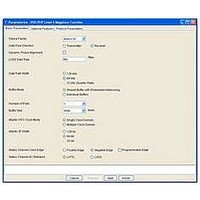IP-POSPHY4 Altera, IP-POSPHY4 Datasheet - Page 103

IP-POSPHY4
Manufacturer Part Number
IP-POSPHY4
Description
IP CORE - POS-PHY Level 4 SPI 4.2 Interface
Manufacturer
Altera
Type
MegaCorer
Datasheet
1.IP-POSPHY4.pdf
(144 pages)
Specifications of IP-POSPHY4
Software Application
IP CORE, Interface And Protocols, COMMUNICATION
Supported Families
Arria GX, Cyclone, HardCopy, Stratix
Core Architecture
FPGA
Core Sub-architecture
Arria, Cyclone, Stratix
Rohs Compliant
NA
Function
POS-PHY Level 4 Interface, Link-Layer/PHY Layer
License
Initial License
Lead Free Status / RoHS Status
na
Lead Free Status / RoHS Status
na
- Current page: 103 of 144
- Download datasheet (3Mb)
Chapter 6: Testbench
Receiver Testbench Examples
Table 6–2. Function Format
Receiver Testbench Examples
December 2010 Altera Corporation
Training
pattern
Idle
Data packet
Command
spi_gen.tp (width, number)
spi_gen.idles (number)
spi_gen.pkt (port_number,
err, size, num)
There are three pattern generation functions capable of generating idles, training
patterns, and data packets.
All of the packets are sent in sequence with no breaks between them. However, idles
can be inserted by adding the idle command in the testbench data generation section.
After all packets have been sent, the idle pattern is repeated until the end of the
simulation.
The testbench concludes by checking that all of the packets have been received. In
addition, it checks that the Atlantic packet receivers (data analyzer modules, one for
each port) have not detected any errors in the received packets. If no errors have been
detected, and all packets have been received, the testbench issues a message stating
that the simulation is successful.
If errors have been detected, a message states that the testbench has failed. If not all
packets have been detected, a message states that the testbench is incomplete. The
tb.exp_chk_cnt variable determines the number of checks done to ensure
completeness of the testbench. For each port tested, one completeness check is done.
In addition, a final check is done for the conclusion of the testbench.
Optionally, the testbench can create backpressure on the SPI-4.2 interface. When the
backpressure variable is defined, backpressure is generated on one or more ports by
first turning off the data analyzer receiver for the appropriate port. As the receive
FIFO buffer begins to fill, it goes from the hungry state to the satisfied state. When the
FIFO buffer is satisfied, the status on the SPI-4.2 interface notifies the packet
generation module to stop sending data. There is a break in packet generation during
which idles are sent. After the status returns to the hungry state, the packet generation
resumes.
In addition to the tasks described in
module also has the following four tasks, which you can use to generate error signals
when running the testbench:
■
■
■
■
Table 6–3
pkt2
task_cw
task_cw2
task_pay
Format
describes the four error generation tasks in more detail.
width is the number of clock cycles the training pattern takes;
number is the number of training pattern sequences.
number is the number of sequential idles
port_number is the target port for the packet. err is set to zero;
size is the packet size in bytes (2-2
sequence number.
Table 6–2
Table 6–2 on page
shows the format of each function.
Description
POS-PHY Level 4 MegaCore Function User Guide
6–3, the packet generation
16
bytes); num is the packet
6–3
Related parts for IP-POSPHY4
Image
Part Number
Description
Manufacturer
Datasheet
Request
R

Part Number:
Description:
IP CORE Renewal Of IP-POSPHY4
Manufacturer:
Altera
Datasheet:

Part Number:
Description:
IP Thermal Transfer Printer With Peel/Present Option
Manufacturer:
BRADY

Part Number:
Description:
CYCLONE II STARTER KIT EP2C20N
Manufacturer:
Altera
Datasheet:

Part Number:
Description:
CPLD, EP610 Family, ECMOS Process, 300 Gates, 16 Macro Cells, 16 Reg., 16 User I/Os, 5V Supply, 35 Speed Grade, 24DIP
Manufacturer:
Altera Corporation
Datasheet:

Part Number:
Description:
CPLD, EP610 Family, ECMOS Process, 300 Gates, 16 Macro Cells, 16 Reg., 16 User I/Os, 5V Supply, 15 Speed Grade, 24DIP
Manufacturer:
Altera Corporation
Datasheet:

Part Number:
Description:
Manufacturer:
Altera Corporation
Datasheet:

Part Number:
Description:
CPLD, EP610 Family, ECMOS Process, 300 Gates, 16 Macro Cells, 16 Reg., 16 User I/Os, 5V Supply, 30 Speed Grade, 24DIP
Manufacturer:
Altera Corporation
Datasheet:

Part Number:
Description:
High-performance, low-power erasable programmable logic devices with 8 macrocells, 10ns
Manufacturer:
Altera Corporation
Datasheet:

Part Number:
Description:
High-performance, low-power erasable programmable logic devices with 8 macrocells, 7ns
Manufacturer:
Altera Corporation
Datasheet:

Part Number:
Description:
Classic EPLD
Manufacturer:
Altera Corporation
Datasheet:

Part Number:
Description:
High-performance, low-power erasable programmable logic devices with 8 macrocells, 10ns
Manufacturer:
Altera Corporation
Datasheet:

Part Number:
Description:
Manufacturer:
Altera Corporation
Datasheet:

Part Number:
Description:
Manufacturer:
Altera Corporation
Datasheet:











